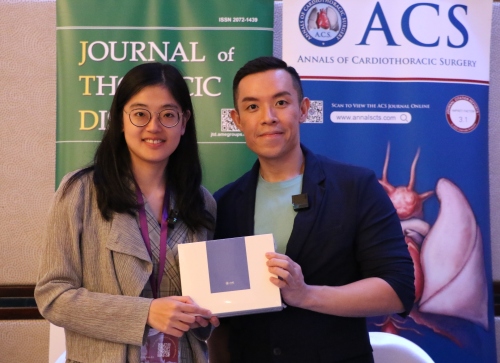Joyce WY Chan1, Brad Li2
1Division of Cardiothoracic Surgery, Department of Surgery, Prince of Wales Hospital, The Chinese University of Hong Kong, Hong Kong SAR, China; 2SHC Editorial Office, AME Publishing Company
Editor’s note
The 2nd Bronchoscopic Ablation Summit (BAS 2023) hosted by the Chinese University of Hong Kong (CUHK) was held successfully in Hong Kong from October 26-27, 2023. Gathering experts from worldwide, the two-day summit presented the latest techniques in advanced navigation and robotic bronchoscopy, imaging and ablation technologies.
During the summit, Dr. Joyce WY Chan from Prince of Wales Hospital, Hong Kong delivered an informative topic on “Concomitant Bronchoscopic Ablations”. We are honored to invite Dr. Chan for a brief interview to share with us some take-home messages of her speech as well as her passion about the use of concomitant ablation for the treatment of lung cancers and its future direction (Figure 1).
Figure 1 Picture with Dr. Joyce WY Chan (left)
Expert introduction
Dr. Joyce WY Chan (Figure 2) is a resident specialist in Cardiothoracic Surgery at Prince of Wales Hospital, Hong Kong. She has been working with Prof. Calvin Ng in electromagnetic navigation bronchoscopy (ENB)-related procedures. Since April 2019, she has been part of the first team in Asia to pioneer ENB microwave ablation of lung cancers in hybrid operating rooms.

Figure 2 Dr. Joyce WY Chan
Interview
SHC: Today you have presented on the topic “Concomitant Bronchoscopic Ablations”. Would you like to share some take-home messages of your speech to our readers?
Dr. Chan: In our study, 25 patients having a total of 56 nodules had concomitant lung nodule ablations in the same operative session. We found that the technique is safe and saves operative and anesthetic times. It provides good patient satisfaction because patients can have one-stop treatment of all the nodules.
SHC: What are the common challenges for this technique?
Dr. Chan: Concomitant ablation would mean a prolonged duration of surgery. Sometimes, we notice that the patients would have carbon dioxide (CO2) retention, especially in patients with smaller body build, where we can only put in a relatively small-sized endotracheal tube. The chance of CO2 retention is higher. And sometimes, we need to remove the bronchoscope in between ablations to ventilate the patient and reduce the CO2. That would be one of the limiting factors for concomitant ablation.
SHC: Have you found ways to overcome this challenge?
Dr. Chan: Yes, basically, we try to insert as big an endotracheal tube as possible. Also, we sometimes would ask the anesthesiologist to pre-oxygenate the patients so that they can withstand a longer period of ablation.
SHC: There are experts from worldwide today sharing their regional experience using the same/similar techniques. What insights have you gained from these sharing/discussion?
Dr. Chan: During our discussion, we found that some of the centers use breath hold during ablation. That would make the catheter relatively stable in relation to the lesion. And some of them even have 10 minutes of apnea during the ablation. This is a technique we haven’t tried before but we are certainly keen to try.
SHC: As we know, you are part of the pioneer team in Asia in performing ENB microwave ablation. Based on your experience, would you like to share some advices on achieving an excellent ablation?
Dr. Chan: I think the most important thing is to have imaging, no matter what kind of imaging it is. In our center, we use cone beam CT (CBCT) to assess the pre- and post-ablative images to determine the margin. This is because for cancer, the most important thing is to have enough margin to prevent recurrence. Therefore, having imaging is most important. If you don’t have CBCT, then you can use EBUS, but CT is preferred.
SHC: What will be your expectation to the future treatment for lung cancers based on the current techniques?
Dr. Chan: My wish is that we would have all of the toys on the market, and that we can make use of the benefits of different toys to treat different lesions, so that we can provide one-stop treatment for patients especially those having multiple lung cancers.

